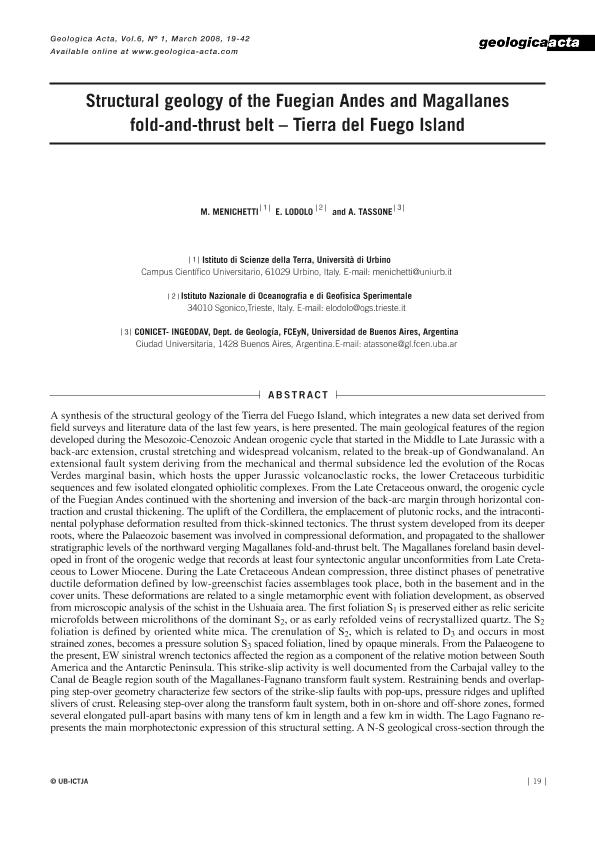Artículo
Structural geology of the Fuegian Andes and Magallanes fold and thrust belt: Tierra del Fuego Island
Fecha de publicación:
12/2008
Editorial:
Universidad de Barcelona
Revista:
Geologica Acta
ISSN:
1695-6133
Idioma:
Inglés
Tipo de recurso:
Artículo publicado
Clasificación temática:
Resumen
A synthesis of the structural geology of the Tierra del Fuego Island, which integrates a new data set derived from field surveys and literature data of the last few years, is here presented. The main geological features of the region developed during the Mesozoic-Cenozoic Andean orogenic cycle that started in the Middle to Late Jurassic with a back-arc extension, crustal stretching and widespread volcanism, related to the break-up of Gondwanaland. An extensional fault system deriving from the mechanical and thermal subsidence led the evolution of the Rocas Verdes marginal basin, which hosts the upper Jurassic volcanoclastic rocks, the lower Cretaceous turbiditic sequences and few isolated elongated ophiolitic complexes. From the Late Cretaceous onward, the orogenic cycle of the Fuegian Andes continued with the shortening and inversion of the back-arc margin through horizontal contraction and crustal thickening. The uplift of the Cordillera, the emplacement of plutonic rocks, and the intracontinental polyphase deformation resulted from thick-skinned tectonics. The thrust system developed from its deeper roots, where the Palaeozoic basement was involved in compressional deformation, and propagated to the shallower stratigraphic levels of the northward verging Magallanes fold-and-thrust belt. The Magallanes foreland basin developed in front of the orogenic wedge that records at least four syntectonic angular unconformities from Late Cretaceous to Lower Miocene. During the Late Cretaceous Andean compression, three distinct phases of penetrative ductile deformation defined by low-greenschist facies assemblages took place, both in the basement and in the cover units. These deformations are related to a single metamorphic event with foliation development, as observed from microscopic analysis of the schist in the Ushuaia area. The first foliation S1 is preserved either as relic sericite microfolds between microlithons of the dominant S2, or as early refolded veins of recrystallized quartz. The S2 foliation is defined by oriented white mica. The crenulation of S2, which is related to D3 and occurs in most strained zones, becomes a pressure solution S3 spaced foliation, lined by opaque minerals. From the Palaeogene to the present, EW sinistral wrench tectonics affected the region as a component of the relative motion between South America and the Antarctic Peninsula. This strike-slip activity is well documented from the Carbajal valley to the Canal de Beagle region south of the Magallanes-Fagnano transform fault system. Restraining bends and overlapping step-over geometry characterize few sectors of the strike-slip faults with pop-ups, pressure ridges and uplifted slivers of crust. Releasing step-over along the transform fault system, both in on-shore and off-shore zones, formed several elongated pull-apart basins with many tens of km in length and a few km in width. The Lago Fagnano represents the main morphotectonic expression of this structural setting. A N-S geological cross-section through the Fuegian Andes synthesizes all the geological and geophysical data. The major stacks of internal thick-skinned basement involved in the thrusting are high-grade Upper Palaeozoic to Lower Tertiary metamorphic rocks. The geometry of the thrust complex is an upright, south plunging monocline of moderately tilted sedimentary cover strata, as well as related thrusts, faults and chevron folds involving the Upper Jurassic and Cretaceous rocks. The orogenic shortening of the Fuegian Andes, including the Cordillera and the Magallanes fold-and-thrust belt, reaches few hundred kilometres with a left-lateral wrenching component of many tens of meters. The Tierra del Fuego Island is characterized by low magnitude (M<3.5) and shallow crustal earthquakes. The southern part presents strong morphological evidence of Quaternary activity, related to the E-W left-lateral strike-slip faults. The actual deformation pattern presents a horizontal slip component of about 6 mm/year. Moreover, the northern sector of the Island is affected by extensional tectonics related to the normal fault systems of the eastern arms of the Magallanes Strait.
Archivos asociados
Licencia
Identificadores
Colecciones
Articulos(IGEBA)
Articulos de INSTITUTO DE GEOCIENCIAS BASICAS, APLICADAS Y AMBIENTALES DE BS. AS
Articulos de INSTITUTO DE GEOCIENCIAS BASICAS, APLICADAS Y AMBIENTALES DE BS. AS
Citación
Menichetti, Marco; Lodolo, Emanuele; Tassone, Alejandro Alberto; Structural geology of the Fuegian Andes and Magallanes fold and thrust belt: Tierra del Fuego Island; Universidad de Barcelona; Geologica Acta; 6; 1; 12-2008; 19-42
Compartir
Altmétricas




